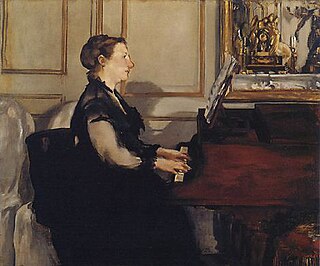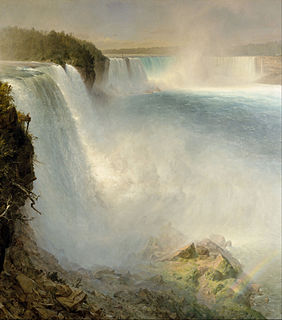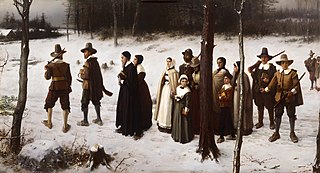 W
WThe Bellelli Family, also known as Family Portrait, is an oil painting on canvas by Edgar Degas (1834–1917), painted c. 1858–1867, and housed in the Musée d'Orsay. A masterwork of Degas' youth, the painting is a portrait of his aunt, her husband, and their two young daughters.
 W
WBoy Blowing Bubbles is an 1867 painting by Édouard Manet, who gave it its present title. It depicts Léon Koelin-Leenhoff, the illegitimate son of Manet's future wife, Suzanne Leenhoff. The painting shows him aged 15 blowing soap bubbles, a traditional symbol of the brevity of life. It is now in the Calouste Gulbenkian Museum in Lisbon, which acquired it via André Weil in New York November 1943.
 W
WThe Death of Caesar is an 1867 painting by the French artist Jean-Léon Gérôme. It depicts the moment after the assassination of Julius Caesar, when the jubilant conspirators are walking away from Caesar's dead body at the Theatre of Pompey, on the Ides of March, 44 BC. The painting is kept at the Walters Art Museum in Baltimore, Maryland.Characteristically, Gérôme has depicted not the incident itself, but its immediate aftermath. The illusion of reality that Gérôme imparted to his paintings with his smooth, polished technique led one critic to comment, "If photography had existed in Caesar's day, one could believe that the picture was painted from a photograph taken on the spot at the very moment of the catastrophe."
 W
WDeath of Dragut is an oil painting by the Maltese artist Giuseppe Calì, from 1867. It depicts the death of the Ottoman general Dragut during the Great Siege of Malta in 1565.
 W
WLe Déjeuner sur l'herbe is an 1866–1867 painting by Claude Monet, a smaller version of a slightly earlier work now in the Musée d'Orsay. It is now in the Pushkin Museum in Moscow.
 W
WDiana is a painting from 1867 by the French painter Pierre-Auguste Renoir. It depicts the painter's lover Lise Tréhot as the Roman goddess Diana.
 W
WThe Family Reunion or Portraits of the Family is an 1867 painting by the French painter Frédéric Bazille. It is now in the collection of the Musée d'Orsay in Paris.
 W
WFrédéric Bazille at his Easel is an 1867 oil on canvas painting by Auguste Renoir, produced in response to Frédéric Bazille's own 1867 portrait of Renoir. It is owned by the Musée d'Orsay, which has deposited it at the Musée Fabre in Montpellier, Bazille's birthplace.
 W
WThe Garden at Sainte-Adresse is a painting by the French impressionist painter Claude Monet.. The painting was acquired by the Metropolitan Museum of Art after an auction sale at Christie's in December 1967, under the French title La terrasse à Sainte-Adresse. The painting was exhibited at the 4th Impressionist exhibition, Paris, April 10–May 11, 1879, as no. 157 under the title Jardin à Sainte-Adresse.
 W
WJerusalem is an 1867 painting by the French artist Jean-Léon Gérôme. It is also known as Golgotha, Consumatum Est and The Crucifixion. The foreground depicts the ground of Golgotha with the shadows of three crucified men: Jesus and the two thieves. Further back in the picture is a crowd of people moving away from the scene. In the background is the city of Jerusalem under a cloudy sky.
 W
WKilling a Deer or A Deer Hunt – The Kill, is a very large picture, representing a hunting scene, painted in 1867 by Gustave Courbet. The picture is currently on display in the Musée d'Orsay of Paris.
 W
WLise, also known as Lise with a Parasol, is an oil-on-canvas painting by the French artist Pierre-Auguste Renoir, created in 1867 during his early Salon period. The full-length painting depicts model Lise Tréhot posing in a forest. She wears a white muslin dress and holds a black lace parasol to shade her from the sunlight, which filters down through the leaves, contrasting her face in the shadow and her body in the light, highlighting her dress rather than her face. After having several paintings rejected by the Salon, Renoir's Lise was finally accepted and exhibited in May 1868.
 W
WLove's Shadow is an 1867 painting by Pre-Raphaelite artist Frederick Sandys. It was modeled by actress Mary Ellen Jones, Sandys common-law wife.
 W
WMadame Manet at the Piano is a portrait by Édouard Manet of his wife Suzanne, produced in 1867-68 and now in the Musée d'Orsay. It highlights her talent on the piano - she played Wagner to Baudelaire during his last days.
 W
WThe Matador Saluting is an oil on canvas painting produced by Édouard Manet between 1866 and 1867. Its precise date is unclear - Charles S. Moffett dates the first definite reference to the work to 1867, at an exhibition devoted to Manet's works at the pavillon de l'Alma.
 W
WMonna Rosa is the title of two oil paintings by Dante Gabriel Rossetti, both of Frances Leyland, the wife of shipping magnate Frederick Richards Leyland. The earlier and smaller painting was completed in 1862 and its whereabouts is now unknown. The second was completed in 1867 and is now in a private collection.
 W
WNiagara Falls, from the American Side is a painting by the American artist Frederic Edwin Church (1826–1900). Completed in 1867, it is based on preliminary sketches made by the artist at Niagara Falls and on a sepia photograph. It is Church's largest painting. The painting is now in the collection of the Scottish National Gallery. Church was a leading member of the Hudson River School of painters.
 W
WOpus 24: Rome, from the Campagna, Sunset is an 1867 oil painting on canvas by Thomas Moran.
 W
WPeasant Girl, spinning is the title given by nineteenth century American expatriate artist Elihu Vedder to an oil painting on canvas that depicts a young female figure spinning wool into thread. The work was completed in 1867 at the artist's studio in Via Margutta, Rome, and represents a slightly scaled up, slightly elaborated version of a theme Vedder had first developed in an oil sketch during the summer of the same year.
 W
WPhryne is an 1867 oil on canvas painting by Artur Grottger, now in the Czartoryski Museum in Krakow, Poland.
 W
WPilgrims Going To Church (1867) — originally The Early Puritans of New England Going to Church — is a painting by Anglo-American painter George Henry Boughton (1833–1905).
 W
WThe Regatta at Sainte-Adresse is an oil-on-canvas painting by the impressionist painter Claude Monet. It was painted in 1867 and is owned by the Metropolitan Museum of Art.
 W
WThe Road in Front of Saint-Simeon Farm in Winter is an oil-on-canvas snowscape painted by French impressionist Claude Monet. It depicts a snow-covered road in front of a barn, with tracks of a horse cart and various footsteps in the snow. The painting is one of four related works from the winter of 1867, and represents Monet’s earliest series. They include this work, followed by Road to the Farm, Saint-Siméon, Honfleur, Road in Front of Saint-Siméon Farm in Winter, and Cart on a Snowy Road at Honfleur.
 W
WSelf-Portrait is an oil-on-canvas painting of 1867 by the Russian artist Ivan Kramskoi. Oval in shape, it is a self-evaluation: Kramskoi indicates how he sees his own facial features and his relationship with the world around him. The artist has rendered himself at 30 years old formally dressed, handsome and intelligent-looking. His pose causes him to be gaze down on the viewer, with an appearance that is, according to the Tretyakov Gallery, "severe and demanding".
 W
WSymphony in White, No. 3, is a painting by James Abbott McNeill Whistler. The work shows two women dressed in white, one sitting on a sofa and the other resting on the floor. The model on the sofa is Joanna Heffernan, the artist's mistress. By calling the painting Symphony in White, No. 3, Whistler intended to emphasise his artistic philosophy of corresponding arts, inspired by the poet Charles Baudelaire. The presence of a fan on the floor shows the influence of Japonisme, which was a popular artistic trend in European art at the time. Whistler was also greatly influenced by his colleague and friend Albert Joseph Moore, and their works show considerable similarities.